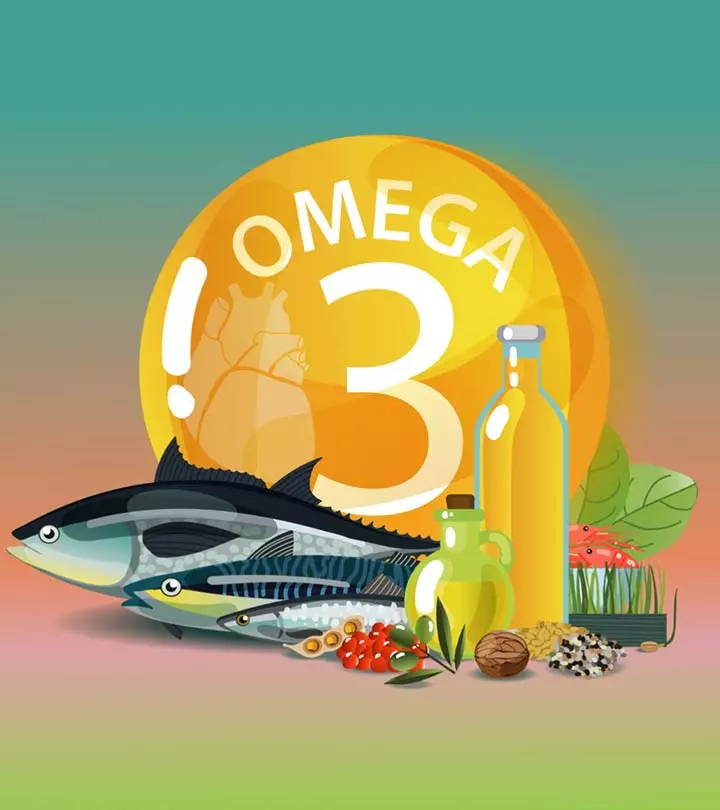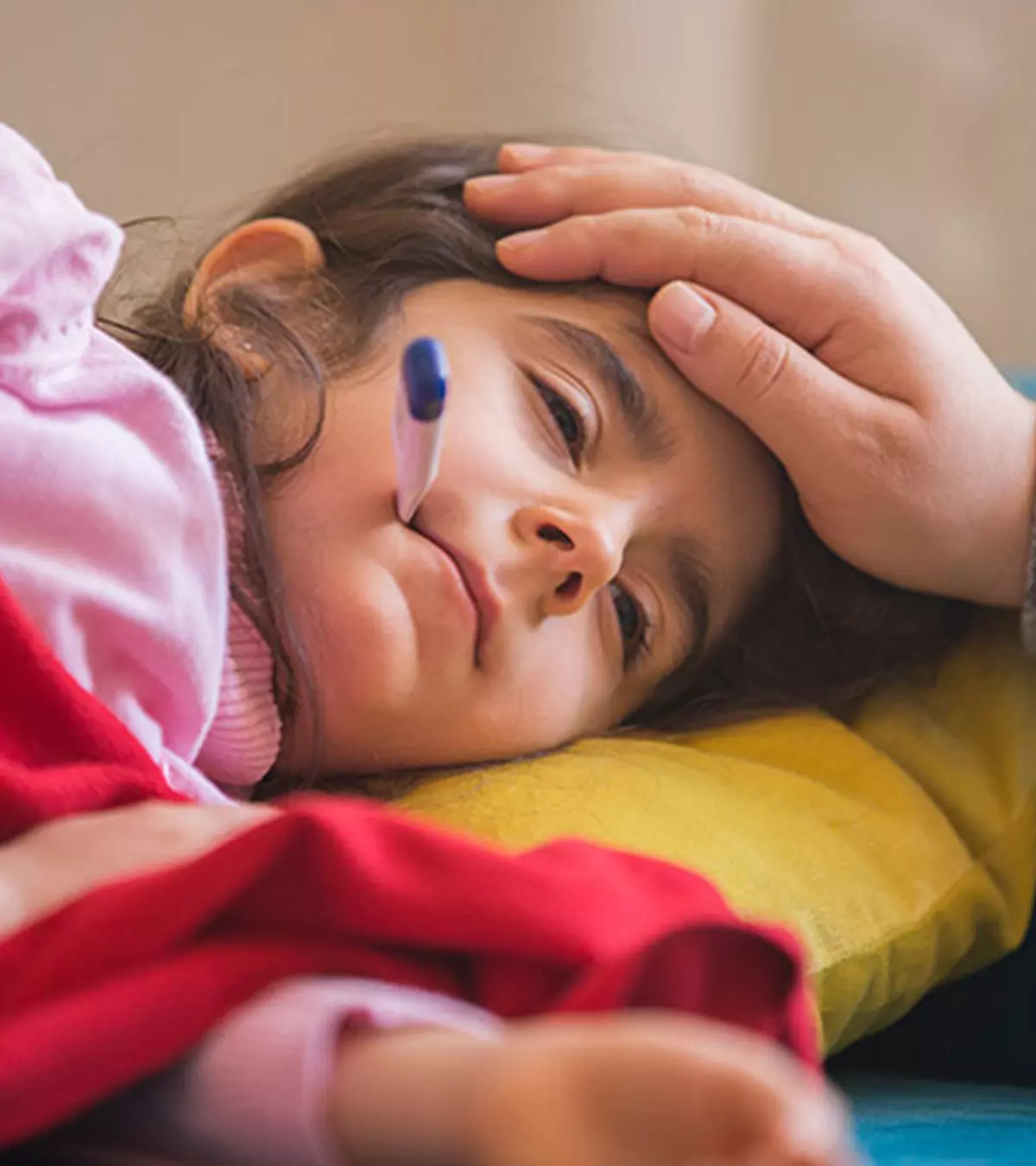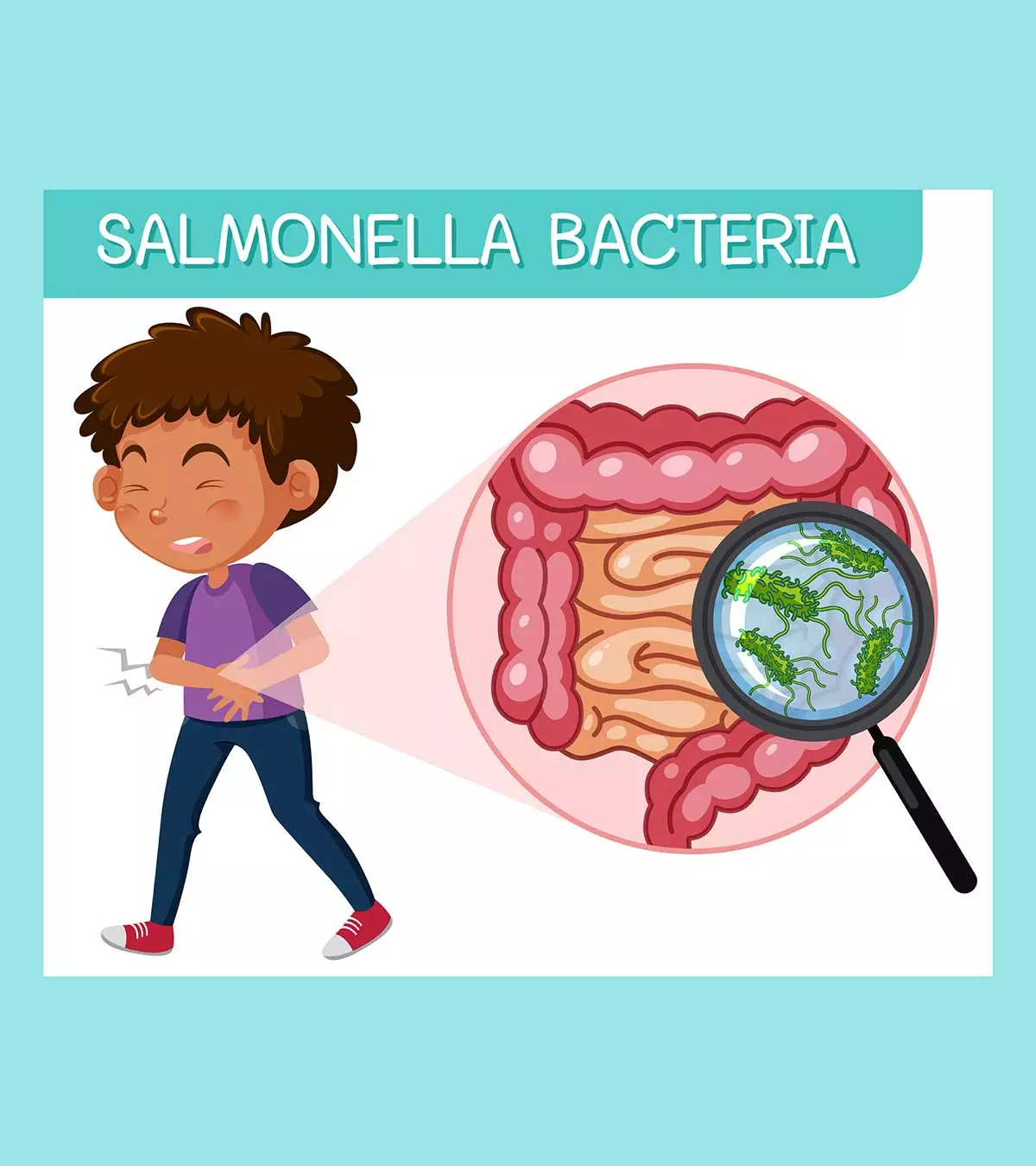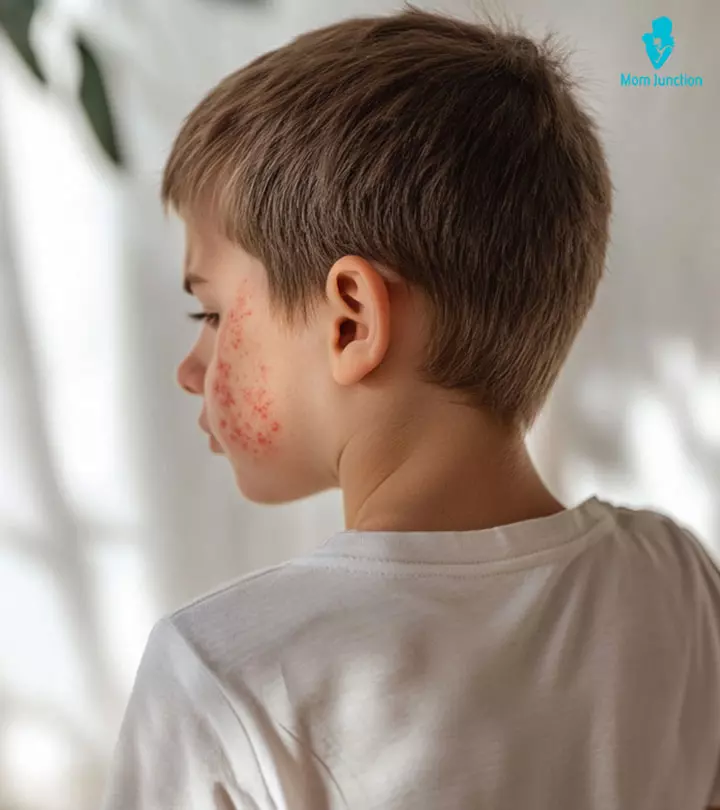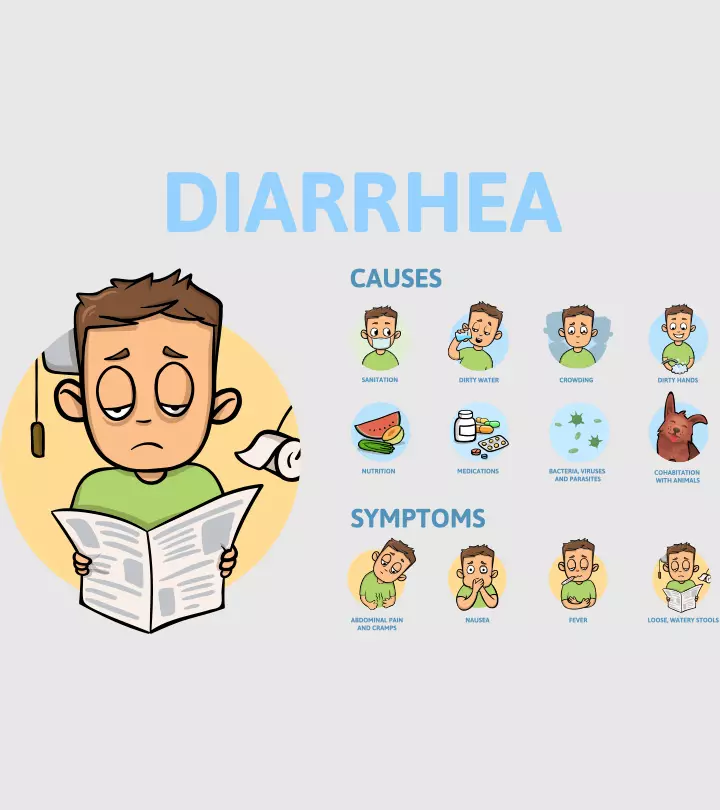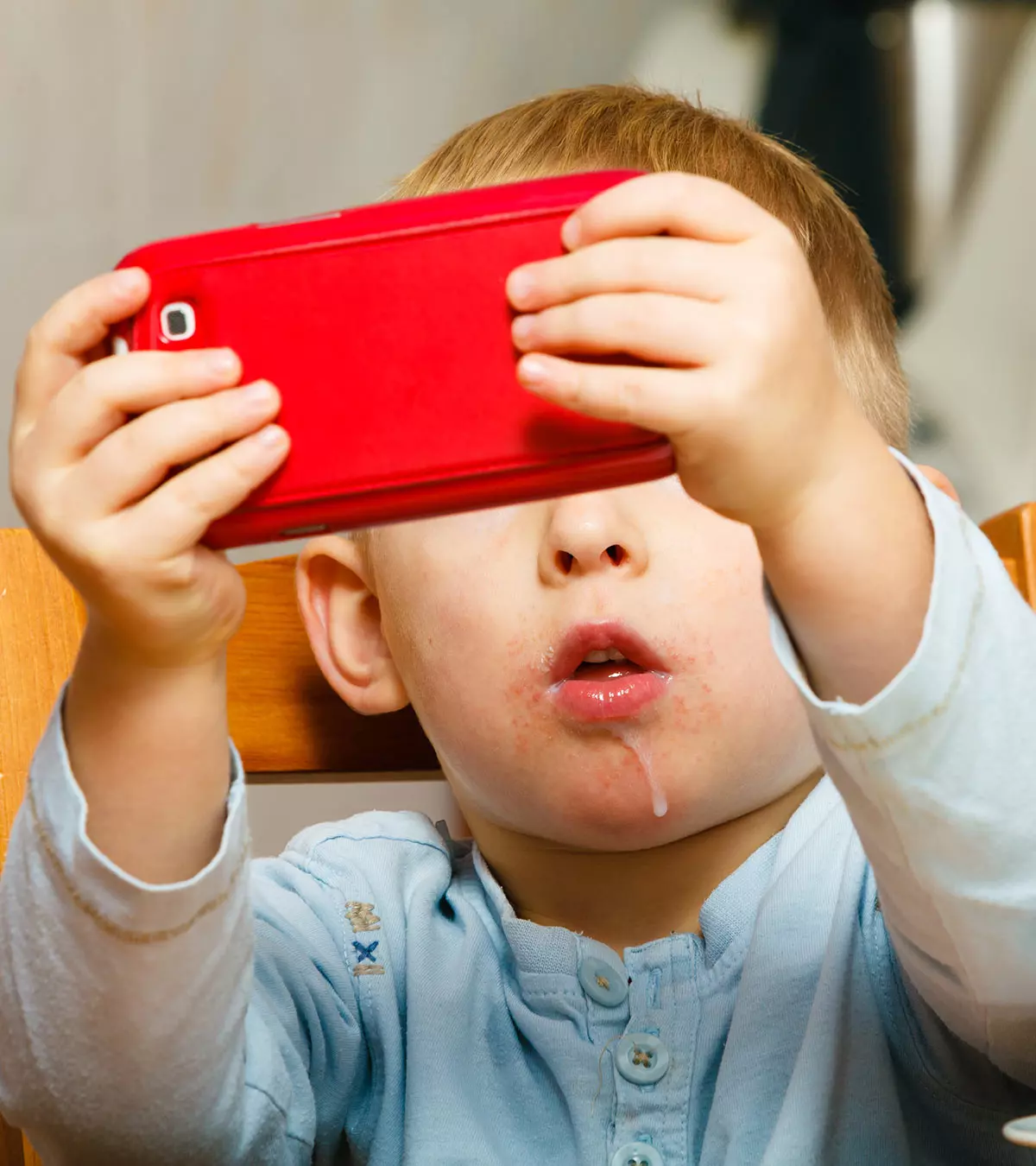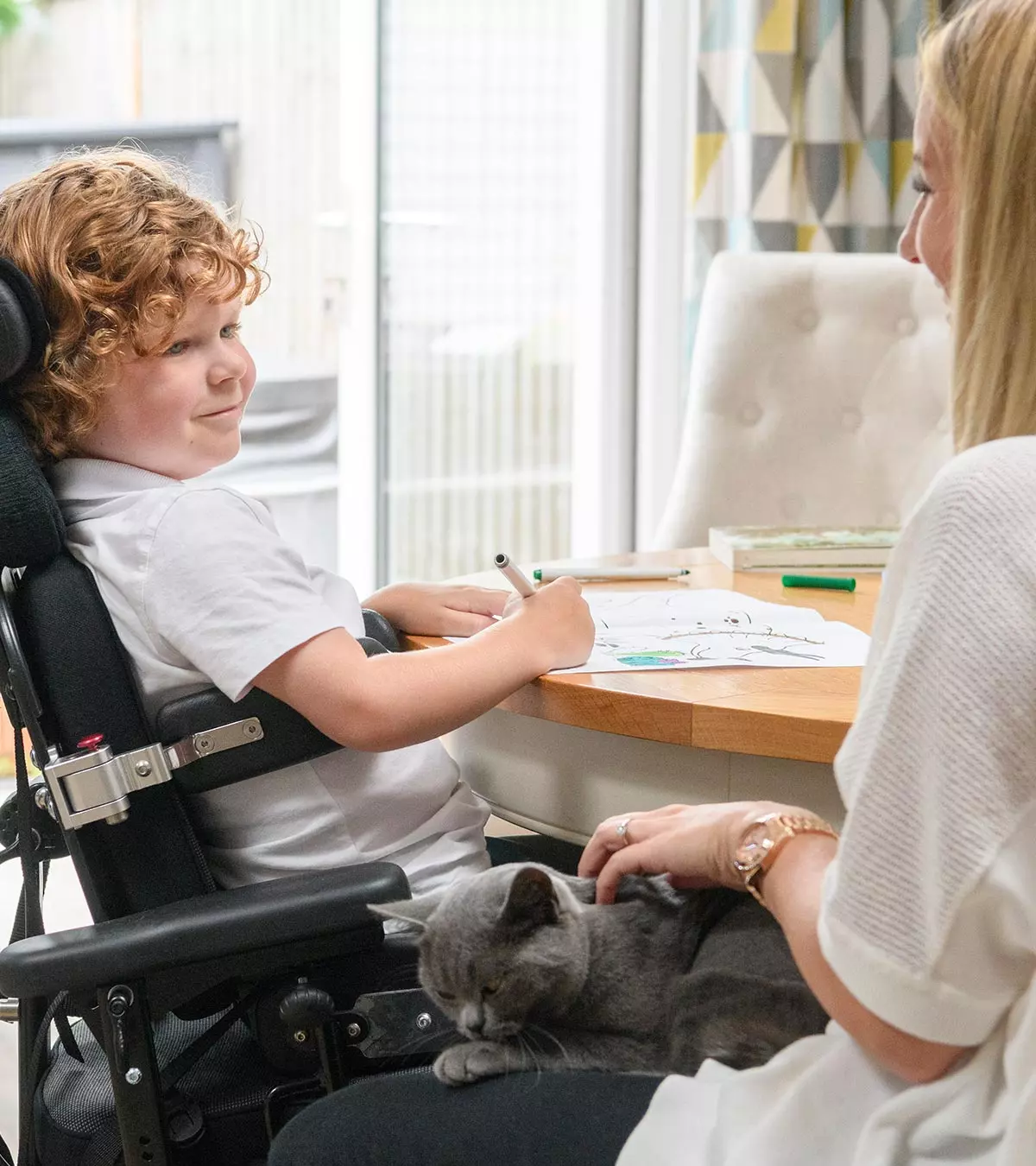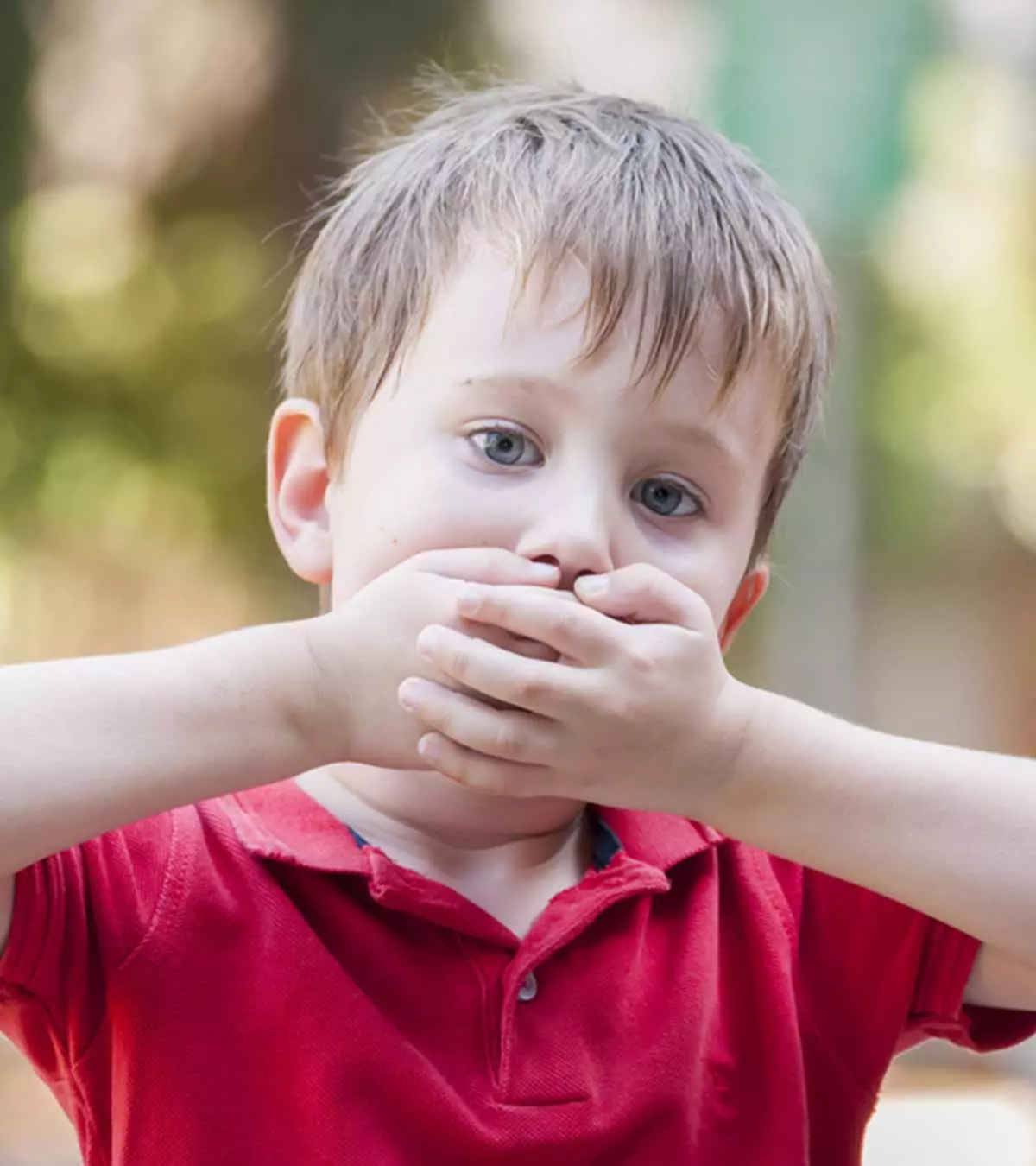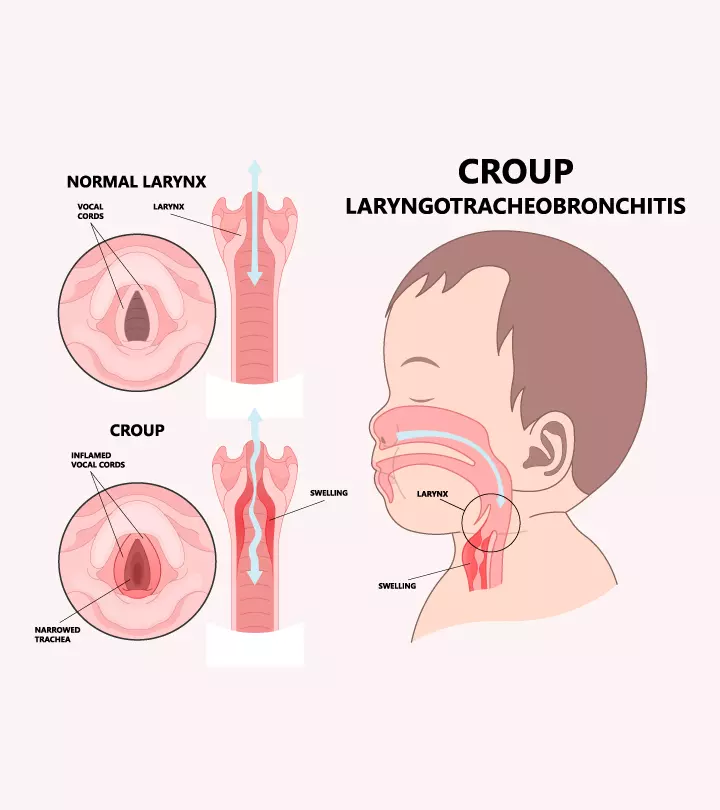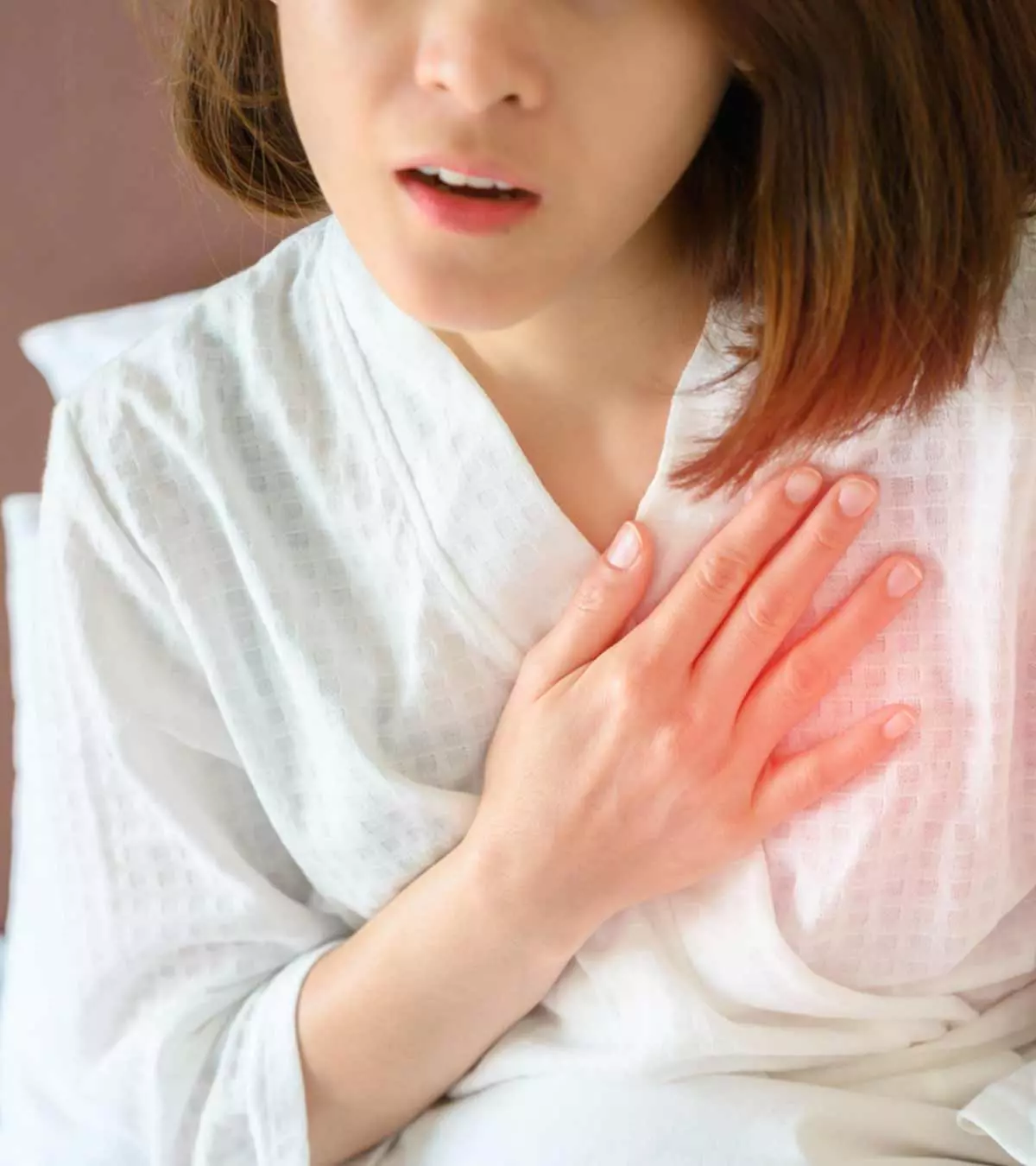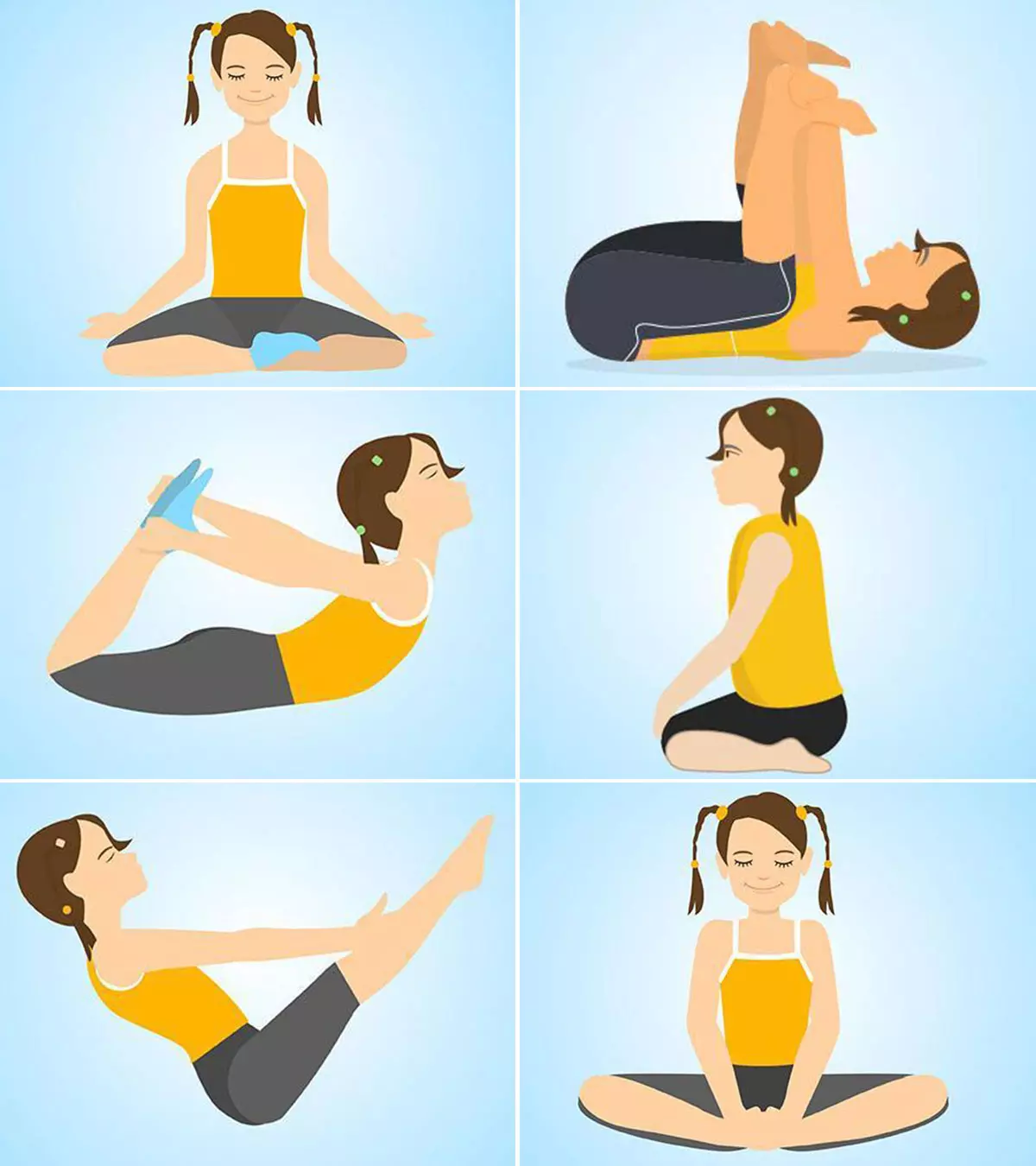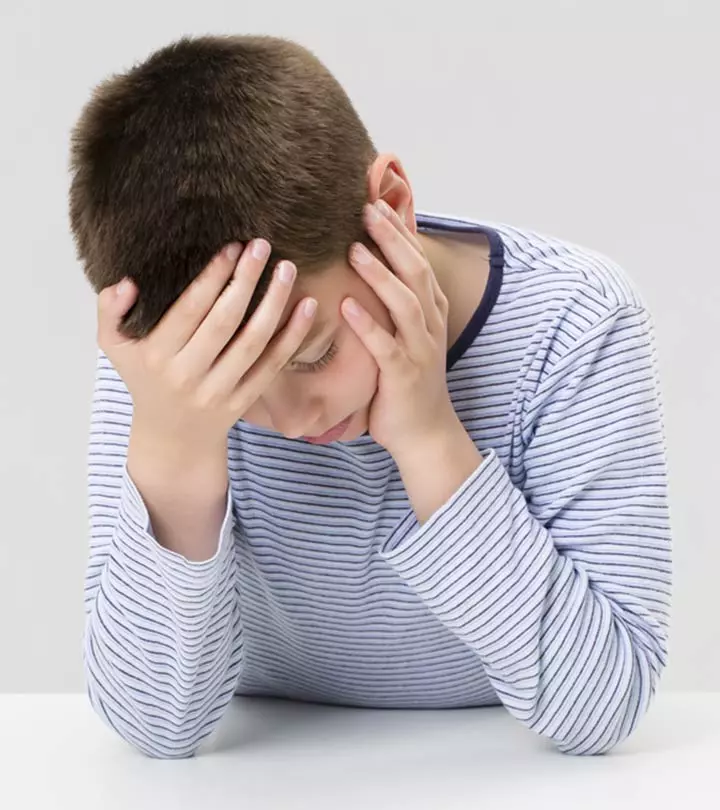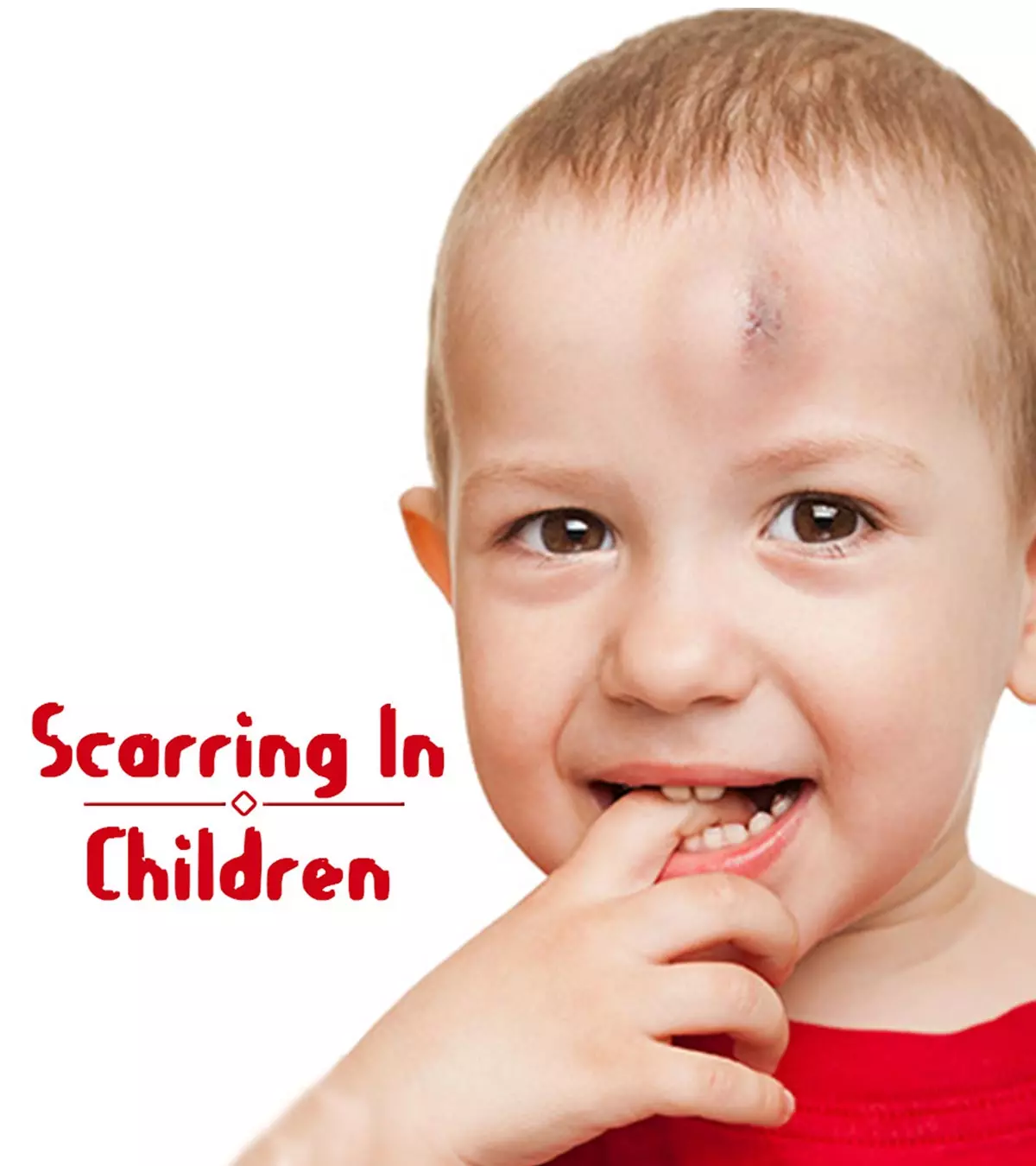
Image: Shutterstock
When your child gets hurt, one of the questions that may arise in your mind is if it will leave a scar. So, we have listed scar treatments in children to help you get a better understanding. While some scars in children are minor and fade away with time, others may stay for a longer duration and may require medical intervention. Recognizing the various types of scars and how they form is essential for identifying the most suitable treatment options (1). Different types of scars may react differently to treatments, making early detection and intervention important. So, here we talk about the different types of scars and their specific treatments. Read on to know more.
Key Pointers
- Scarring is a normal healing process that occurs following an injury such as burns, cuts, and surgeries in children.
- The morphology of scars and treatment options depend on the severity and type of injury.
- Most scars may fade over time with the help of specialized therapies and topical applications, but some may require surgical interventions.
- To prevent scarring, protective gear should be used while playing, wounds should be cleaned promptly, and existing scars should be avoided from being poked.
How Are Scars Formed?
A scar is a mark left on the skin after a wound or injury has healed (2). The formation of a scar is part of the normal healing process of skin that was damaged by surgery, trauma, or burns (3). Scientific evidence suggests that the immune system might contribute to the development of such scarring (4).
Wounds can take time to heal. Here is how a wound is healed and a scar may form (5).
- The inflammation lasts for two weeks, and during this period, the body tries to heal the wound. At this phase, the wound is red, tender, and swollen.
- In the proliferation phase, the skin goes through a repair, and it might take about six weeks. In this phase, the scar appears raised, red, and rigid.
- The final phase is remodeling, wherein the scar becomes flat and soft. It might take 12 to 18 months.
Every scar is different since every injury or damage to the skin is different. It is essential to understand the type of scar before proceeding with treatment.
Different Types Of Scars
Some scars take less time to heal, while a few might take longer (1) (2) (6) (7).
1. Keloid scars

These grow at the wound site and result due to overproduction of collageniA structural protein of the body that helps build the connective tissue, skin, bones, and tendons and provides flexibility during remodeling of the wound. These appear round, thick, and dark in color. These might be painful or itchy and may even restrict the movements if they are around a joint area. They can appear on any part of the body and could recur.
2. Hypertrophic scars

These are similar to keloid scars, but their growth is not beyond the boundary of the skin’s wound. These are thick, elevated, and red. These scars continue to thicken for months but can get better over a year or more.
3. Sunken scars

Certain skin conditions such as chickenpox, acne, or bruise may leave pitted or sunken scars. They are also known as atrophiciRelated to atrophy, meaning restricted growth of muscle tissue or depressed scars. They usually appear on the face (8).
4. Scar contractures
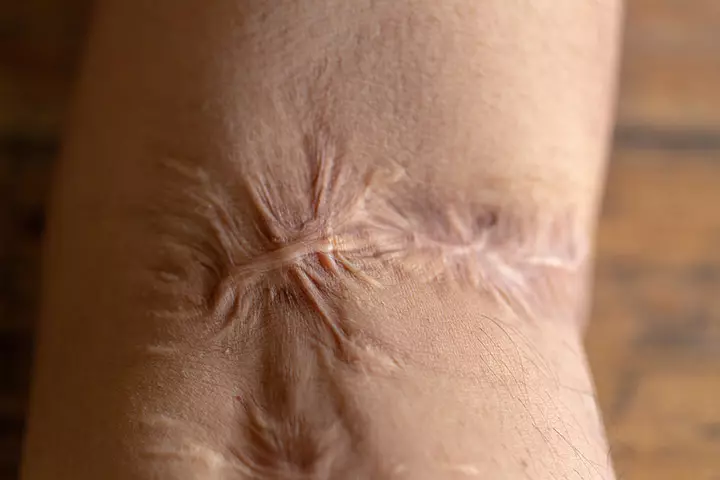
Research suggests that scar contracture is the most common complication in children (9). These scars are often formed when the skin is damaged due to burns. Some contractures may affect underlying tendons, joints, and muscles. TendonsiTough fibrous tissues that connect the muscles to bones or other structures become shorter and harder and may lead to deformity or rigidity in joints, thus impairing movement.
The exact science behind formation of scars is still not fully understood. However, certain factors are known to play a significant role in their development. Among these, the most important are the age of the individual, their ethnic background, and the location of the wound. While other factors have been suggested, they don’t have as strong of an impact (1).
A doctor will suggest the appropriate treatment based on the type and extent of a scar. According to Dr. Bidisha Sarkar, “Scars do not necessarily get worse with age, but they may change in appearance as the skin ages. For example, scars may become more noticeable or prominent as the skin loses elasticity and collagen over time. Scars may also fade or darken, depending on factors such as sun exposure, genetics, or hormonal changes. The best way to prevent scars from worsening with age is to protect them from sun damage and moisturize them regularly.”
 Quick tip
Quick tipScar Treatments In Children
Small or minor scars may fade away on their own. But some broad or deep scars may require treatment. As the treatment plan for a scar could vary, talk to your child’s pediatrician to know about various options. It is important to realize that the outcomes are better in scars where treatment interventions are initiated in the early phases of wound healing.
- Topical treatment: Prescription lotions, creams, gels, and moisturizers with vitamin E or oil may help improve the appearance of scars by making them less visible. Skin products such as Mederma, Aquaphor, and Eucerine may soften the scar. Before using any such product, it is essential to consult a dermatologist (3).
 Quick tip
Quick tip- Pressure therapy: A pressure dressing such as a stocking or elastic bandage is applied on the wound to reduce the scar or prevent the recurrence of keloid (when it is removed surgically) (6).
- Laser therapy: The upper layers of the scar tissue are removed using laser light, thus reducing the thickness of the scar. Laser treatment is recommended based on the depth of the scar. The scar may remain but become less prominent. Laser therapy works for most types of scars, including keloid scars (11). A study conducted on children aged 2 to 10 years with post-burn hypertrophic scars found that laser therapy was effective in improving scar conditions. The report states, “Photobiomodulation (PBM) is an efficient and safe therapeutic modality for post-burn hypertrophic scars in children, with no side effects, and should be considered a part of combination therapy for better results (12).”
- Injections: CorticosteroidiA group of steroid hormones produced in the adrenal cortex and are used for treatments in synthetic form to reduce inflammation injections are administered at the scar to reduce its size and improve the appearance (13). This treatment is more likely to be used with hypertrophic and keloid scars. Corticosteroid injections can also help reduce pain, itchiness, and redness caused by the scar. Some scars may get reduced by half or go away completely. These injections may have side effects, which need to be first discussed with the dermatologist.
If a scar does not respond to other modes of treatment or gets worse, then surgical removal might be the solution. There are usually two ways to treat the scar surgically (14) (15).
- Scar revision: These techniques are intended to reduce the size of the scar or blend it with the skin. Some of the methods include Z-plasty, laser resurfacing, and dermabrasioniA cosmetic surgery performed to remove superficial layers of skin .
- Scar removal: This is suitable to remove keloids, hypertrophic scars, or scars caused by burns. Depending on the scar, surgeons may opt for a reconstructive approach to replace the damaged scar with normal skin (skin grafting).
- Silicone gel and sheets: Scars caused by skin burns could be treated with silicone gel and sheets. These sheets are comfortable, easy to use, provide no hindrance to movement, and are safe for children (16).
- Cryosurgery: It involves the application of freezing temperatures to a scar to destroy the lesion. It may help restore the child’s skin health to its normal texture. A doctor might recommend this treatment in cases of severe scarring (17).
Newer therapies that target specific molecules may be used for treating postburn hypertrophic scars and keloids in children. These include treat itching, and providing moisture and flexibilityments that focus on cytokines, growth factors, and even gene therapy (18). The right care and precautions may help prevent scarring.
 Quick fact
Quick factRight care and precautions may help prevent scarring.
How To Prevent Scars In Children?
A few tips may help prevent a significant scar, and some prompt actions could help minimize the extent of a scar on your child (19) (20) (21).
- For small scrapes and cuts, wash the wound with water and soap. Cleaning helps reduce the chances of infection and may help prevent scarring. Once the wound is cleaned, you may apply antibacterial cream and use a bandage.
- If the cut is more profound or the bleeding doesn’t stop, you may take your child to the doctor.
- Encouraging your child to wear protective gear such as helmets and pads while cycling or skating may prevent any significant injury.
- Avoiding harsh sun rays may also prevent any existing scars from intensifying.
- Never itch or poke an existing scar, as it may get infected and aggravated.
- Don’t apply any products that claim to reduce the scar. Use only the ones that are recommended by a dermatologist.
Preventing scars involves not only immediate care but also long-term skin health. By taking these preventive steps, parents can help reduce the risk of scarring and support better healing for their children.
Frequently Asked Questions
1. My child has a scar that seems to be getting bigger. Should I be concerned?
If the prescribed treatment options are not helping, and the scar is turning bigger, you may take your child to the doctor. A medical diagnosis is required to understand the type of scar, and then a treatment plan is suggested.
2. Do children’s scars fade?
It depends on the type of scar and its depth. Small scars such as cuts and scrapes usually fade away with time, but the bigger and deeper ones need time and proper treatment.
3. Can an old scar get infected?
If an old scar is turning itchy, painful, swollen, or has turned red, then it may be due to a bacterial infection. In that case, you may consult the doctor.
4. How long does a scar stay pink in children?
The pink color of the scar is generally the second stage for a scar or a wound. It stays pink for at least three to six months after the scar first appeared, and over time it gradually turns lighter (22ea to lighten the visible marks).
5. Can I use scar cream on children?
To treat scars on children, creams such as Mederma and Aquaphor can be applied to the scar area to lighten the visible marks (3Get tips on how to make wounds heal quickly and safely).
Scars in children are seldom a cause for concern. While some scars will stay longer, others might fade over time. There are plenty of sophisticated treatment options to treat scars in children. But it is better to remain patient until the wounds heal and the scars fade by themselves. You can prevent scars by washing the wound, applying antibacterial cream, using a bandage, and avoiding harsh sun rays. However, if the bleeding doesn’t stop, you should take your child to the doctor.
Infographic: How Can Scars Be Prevented In Children?
Children who have undergone surgery or sustained a skin injury may develop scars. Even though scars are a normal part of the healing process, they can be upsetting. Therefore, it is crucial to prevent scarring in children. Check out the infographic below for some pointers on avoiding scarring in children. Illustration: Momjunction Design Team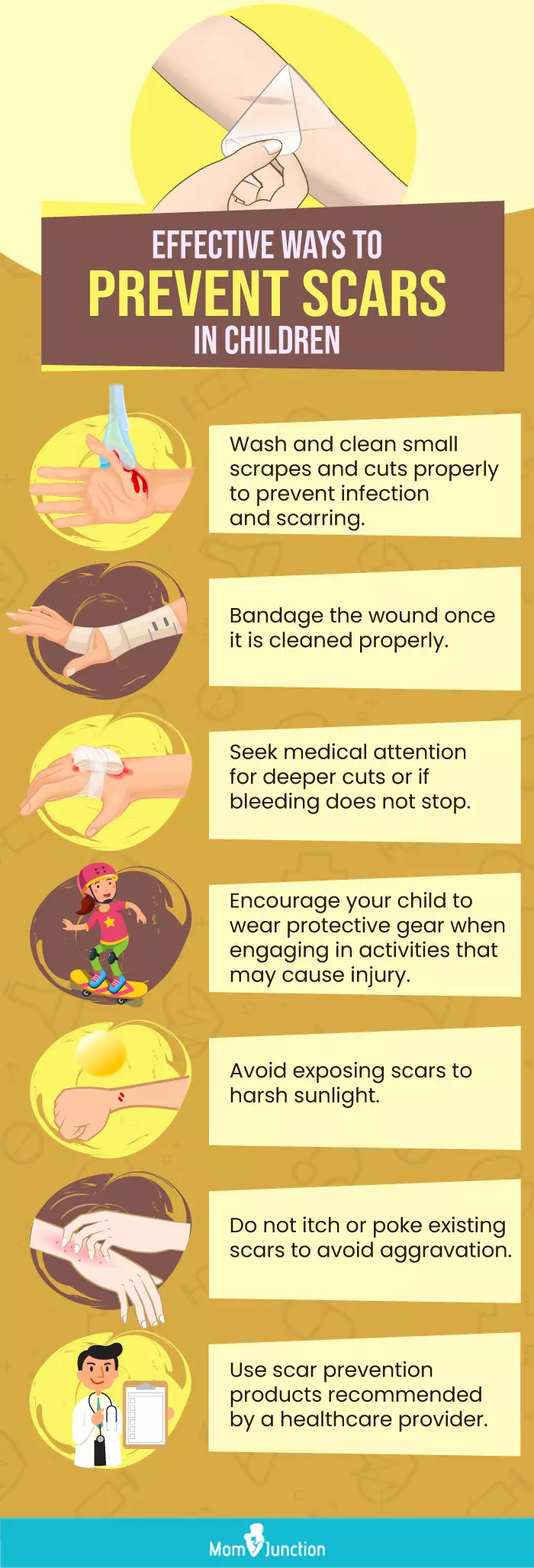
It is common for children to get wounds when playing. Learn how to properly care for your child’s cuts, scrapes, and scars in this informative video. Get tips on how to make wounds heal quickly and safely.
References:
- Scars in Pediatric Patients.
https://www.ncbi.nlm.nih.gov/books/NBK586080/ - Scars.
https://www.nhs.uk/conditions/scars/ - Scar Management.
https://www.nationwidechildrens.org/family-resources-education/health-wellness-and-safety-resources/helping-hands/scar-management - I. Westra et.al; (2017); Investigating histological aspects of scars in children.
https://www.magonlinelibrary.com/doi/abs/10.12968/jowc.2017.26.5.256 - Reconstructive Plastic Surgery.
https://www.moffitt.org/treatments/surgical-care/reconstruction-surgery/ - Scars.
https://lluh.org/conditions/scars - Keloid Scars.
https://stanfordhealthcare.org/medical-treatments/s/scar-revision-surgery/procedures/keloid-scars.html - Scars.
https://my.clevelandclinic.org/health/diseases/11030-scars - Zhe Zhu et.al; (2023); Epidemiological and clinical features of paediatric inpatients for scars: A retrospective study.
https://www.sciencedirect.com/science/article/abs/pii/S0305417923000268 - Scars: Diagnosis and treatment.
https://www.aad.org/public/diseases/a-z/scars-treatment - Laser Treatment of Scars.
https://www.bcm.edu/healthcare/specialties/dermatology/laser-surgery/laser-treatment-of-scars - Jehan Alsharnoubi et.al; (2018); Evaluation of scars in children after treatment with low-level laser.
https://idp.springer.com/authorize?response_type=cookie&client_id=springerlink&redirect_uri=https%3A%2F%2Flink.springer.com%2Farticle%2F10.1007%2Fs10103-018-2572-z - Medical Treatment for Scars & Keloids.
https://nyulangone.org/conditions/scars-keloids/treatments/medical-treatment-for-scars-keloids - Surgery for Scars & Keloids.
https://nyulangone.org/conditions/scars-keloids/treatments/surgery-for-scars-keloids - Treatments and Procedures: Scar Revision.
https://www.hopkinsmedicine.org/otolaryngology/specialty-areas/facial-plastic-reconstructive/cosmetic-surgery/scar-revision - M Argirova et.al; (2006); Non-Operative Treatment of Hypertrophic Scars and Keloids After Burns in Children.
https://pmc.ncbi.nlm.nih.gov/articles/PMC3188029/ - Cutaneous Cryosurgery.
https://www.aafp.org/pubs/afp/issues/2012/1215/p1118.html - Brian Berman et.al; (2008); Prevention and Management of Hypertrophic Scars and Keloids After Burns in Children.
https://journals.lww.com/jcraniofacialsurgery/abstract/2008/07000/prevention_and_management_of_hypertrophic_scars.22.aspx - Scars.
https://kidshealth.org/en/kids/scars.html/a> - Everyday Cuts and Scrapes: How to Prevent Scarring.
https://www.hopkinsmedicine.org/health/wellness-and-prevention/everyday-cuts-and-scrapes-how-to-prevent-scarring - Cuts, Scrapes & Scar Management: Parent FAQs.
https://www.healthychildren.org/English/health-issues/injuries-emergencies/Pages/Treating-Cuts.aspx - Jeremy S Bond et.al; (2008); Scar redness in humans: how long does it persist after incisional and excisional wounding?
https://pubmed.ncbi.nlm.nih.gov/18300967/#:~:text=Conclusions%3A%20Scar%20redness%20fades%20on,the%20wound%20type%20and%20position. - Preventing Burn Scars and Contractures in Children.
https://www.nationwidechildrens.org/conditions/health-library/preventing-burn-scars-and-contractures-in-children
Community Experiences
Join the conversation and become a part of our nurturing community! Share your stories, experiences, and insights to connect with fellow parents.
Read full bio of Dr. Zeel Gandhi
- Dr. Bidisha Sarkar is a pediatrician with nine years of experience. She did her graduation in Medicine from NRS Medical College, Kolkata and holds specialization in Pediatrics. Dr. Sarkar currently practices at KIMS Hospital in Hyderabad, India.
 Dr. Bidisha Sarkar is a pediatrician with nine years of experience. She did her graduation in Medicine from NRS Medical College, Kolkata and holds specialization in Pediatrics. Dr. Sarkar currently practices at KIMS Hospital in Hyderabad, India.
Dr. Bidisha Sarkar is a pediatrician with nine years of experience. She did her graduation in Medicine from NRS Medical College, Kolkata and holds specialization in Pediatrics. Dr. Sarkar currently practices at KIMS Hospital in Hyderabad, India.
Read full bio of Dr. Ritika Shah
Read full bio of Swati Patwal
Read full bio of Ghazia Shah








